The Qualcomm Snapdragon 820 Performance Preview: Meet Kryo
by Ryan Smith & Andrei Frumusanu on December 10, 2015 11:00 AM EST- Posted in
- SoCs
- Snapdragon
- Qualcomm
- Snapdragon 820
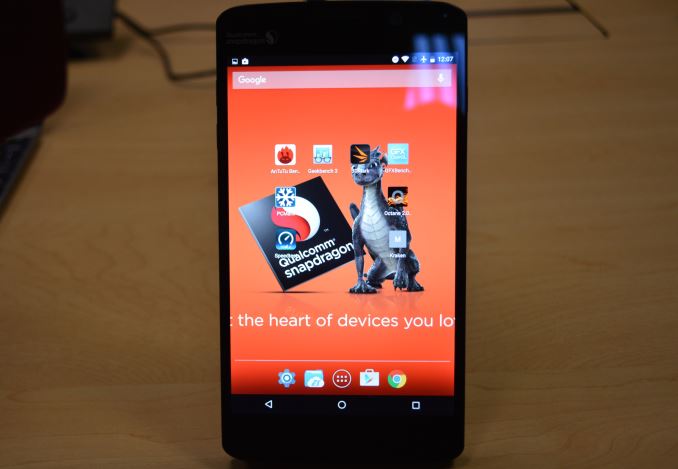
I don’t think there’s any way to sugarcoat this, but 2015 has not been a particularly great year for Qualcomm in the high-end SoC business. The company remains a leading SoC developer, but Snapdragon 810, the company’s first ARMv8 AArch64-capable SoC, did not live up to expectations. Seemingly held back by design matters and a rough 20nm planar manufacturing process – a problem shared by many vendors in the last year – Snapdragon 810 couldn’t make good use of its highly clocked ARM Cortex-A57 cores, and ultimately struggled in the face of SoCs built on better processes such as Samsung’s surprisingly early Exynos 7420.
But the purpose of today’s article isn’t to reminisce about the past, rather it’s to look towards the future. Qualcomm knows all too well what has happened in the past year and the cost to the company that has come from it, so now they need to dust themselves off and try again. With Samsung’s more advanced 14nm FinFET process in hand, a new CPU core, a new GPU, and a number of other advancements, Qualcomm is ready to try again; to try to recapture the good old days of 28nm and their Krait CPU architecture.
To that end Qualcomm started talking about Snapdragon 820 early and doing so loudly. Last month the company held their first press demonstration of the SoC, showcasing early demonstrations in action and going into more detail than ever before on their performance and power projections for their next-generation SoC.
If there is any unfortunate aspect to any of this, it’s that while Qualcomm is showing off Snapdragon 820 today, it won’t be ready for the holidays (lining up with what we expect will be the typical spring smartphone refreshes). But some of this is clearly driven by Qualcomm’s business needs and the aforementioned effort at Qualcomm to quickly pick themselves up and try again.
Meanwhile after last month’s demonstrations, this month Qualcomm is ready to move on to the next phase in what has become their traditional roll-out process for a new SoC: giving the press access to the company’s Mobile Development Platform (MDP) devices. Designed for software developers to begin building apps and (for lack of a better word) experiences around the new SoC, the MDP is something of the home-stretch in SoC development, as it means Qualcomm is ready to let the press and developers see the hardware and near-final software stack. We’ve previously previewed the Snapdragon 800, 805, and 810 via their MDPs, and for Snapdragon 820 Qualcomm has once again opted to do the same. So without further ado, let’s take our first look at Snapdragon 820.
| Qualcomm Snapdragon S810 Specifications | |||
| SoC | Snapdragon 820 | Snapdragon 810 | Snapdragon 800 |
| CPU | 2x Kryo@1.593GHz 512KB(?) L2 cache 2x Kryo@2.150GHz 1MB(?) L2 cache |
4x A53@1.555GHz 512KB L2 cache 4x A57@1.958GHz 2MB L2 cache |
4x Krait 400@2.45GHz 4x512KB L2 cache |
| Memory Controller |
2x 32-bit LPDDR4 @ 1803MHz 28.8GB/s b/w |
2x 32-bit LPDDR4 @ 1555MHz 24.8GB/s b/w |
2x 32-bit LPDDR3 @ 933MHz 14.9GB/s b/w |
| GPU | Adreno 530 @ 624MHz |
Adreno 430 @ 600MHz |
Adreno 330 @ 600MHz |
| Mfc. Process |
Samsung 14nm LPP |
TSMC 20nm SoC |
TSMC 28nm HPm |
Taking a trek down to sunny San Diego, Qualcomm handed to us the Snapdragon 820 MDP/S. A 6.2” phablet, the MDP/S is a development kit designed for function over form, containing a full system implementation (sans cellular) in an otherwise utilitarian design. Along with the Snapdragon 820 SoC, the 820 MDP/S also includes a 6.2” 2560x1600 display, 3GB of LPDDR4 memory runnning at a slightly higher 1804MHz instead of 1555MHz we've seen on the Snapdragon 810 and Exynos 7420, a 64GB Universal Flash Storage package, a 21MP rear camera, 802.11ac WiFi, and a Sense ID ultrasonic fingerprint scanner. Overall the aesthetics of the MDP/S differs significantly from what retail phones will go for, but internally the MDP/S won’t be far removed from the kinds of configurations we’ll see in 2016 smartphones.
Overall there’s little to report on the MDP/S experience itself. Qualcomm is still sorting out some driver bugs – only one device in our group was ready to run PCMark – and to be sure like past Qualcomm MDP previews this is very much a preview. However the experience was otherwise unremarkable (in a good way) with our unit completing all of our tests bar part of SPEC CPU 2000, which will require further analysis.
More interesting from a testing perspective is that Qualcomm opted to demonstrate Snapdragon 820 using the MDP/S smartphone development kit, instead of a larger MDP/T tablet development kit. Qualcomm has used MDP/T for the press demonstrations on both Snapdragon 800 and Snapdragon 810, so the fact that they are once again using the MDP/S is very notable. From a pure performance perspective the MDP/T allowed Qualcomm to show off previous Snapdragon designs at their best – these are just performance previews, after all – but after Snapdragon 810 I don’t doubt that had this been another MDP/T that the 820’s thermals and power consumption would be called into question. So instead we are looking at 820 in a phablet, and while this may not put 820 in the best possible light, the end result is that we get to see what performance in a large phone looks like, and for Qualcomm there isn’t any doubt about 820’s suitability for a smartphone.
As for Snapdragon 820 itself, we’ve already covered the SoC in some depth in past articles – and this week’s preview doesn’t come with much in the way of new architectural information – but here’s a quick recap of what we know so far. 820 uses a new Qualcomm developed CPU core called Kryo. The quad core CPU is best described as an HMP solution with two high-performance cores clocked at 2150 MHz and two low-power cores clocked at 1593MHz. The CPU architectures of both clusters are identical, but with differences in cache configuration and their power/frequency tuning.
Meanwhile the GPU inside 820 is the Adreno 530. This is a next-generation design from Qualcomm and includes functionality that until now has only been found in PC desktops, such as shared virtual memory with the CPU, which allows an OpenCL host program and a device's kernel to share a virtual address space so access to data structures like lists and trees can be easily shared between the host and GPU. The underlying architecture is capable of Renderscript and OpenCL 2.0 on the compute side – a significant step up from Adreno 400 – and on the graphics side supports OpenGL ES 3.1 + AEP and Vulkan. We know the 530 should be powerful, but like past Qualcomm designs the company is saying virtually nothing about the underlying architecture.
Finally, while it’s not something that can be covered in our brief testing, the 820 contains a new DSP block, the Hexagon 680. Hexagon 680 and its Hexagon Vector Extensions (HVX) are designed to handle significant compute workloads for image processing applications such as virtual reality, augmented reality, image processing, video processing, and computer vision. This means that tasks that might otherwise be running on a relatively power hungry CPU or GPU can run a comparatively efficient DSP instead. The HVX has 1024-bit vector data registers, with the ability to address up to four of these slots per instruction, which allows for up to 4096 bits per cycle.


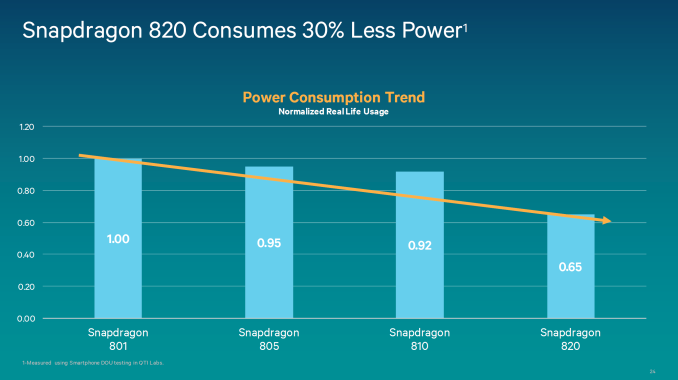
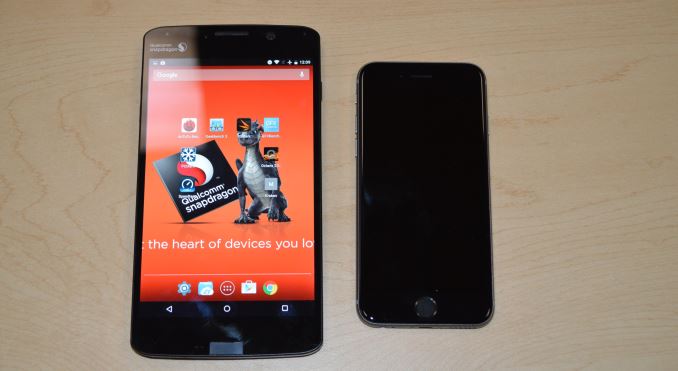
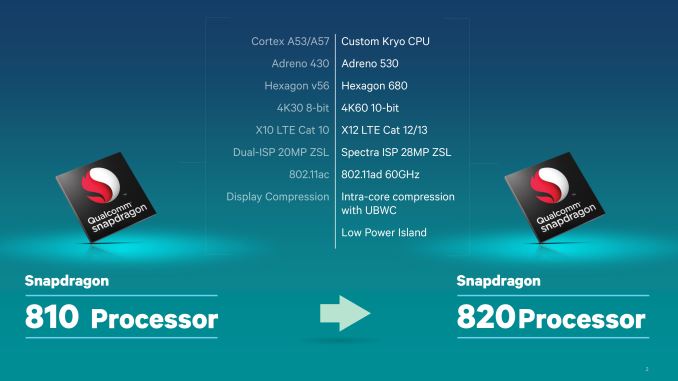
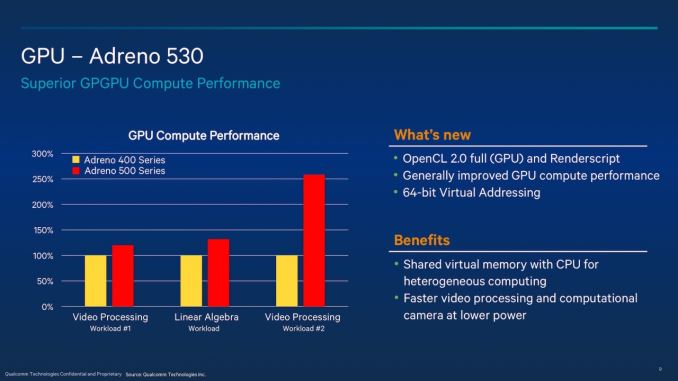
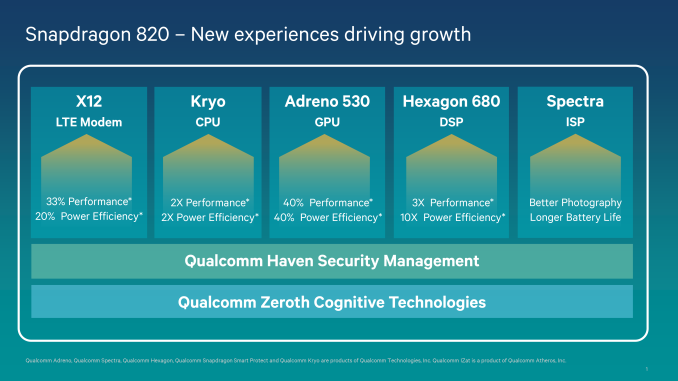








146 Comments
View All Comments
V900 - Friday, December 11, 2015 - link
In quite a few examples also coming in behind the A8, which is two years older than this SOC will be when it hits the street, don't forget about that!In all fairness, Qualcomm's development devices, like the mdp820, are rarely tuned for performance, and many of the drivers may still have some rough edges around them.
But they're also nowhere near as demanding in terms of battery size and thickness as the production models that vendors will release sometime next year.
The MDP820 is 11 mm thick, and has a battery with over 3000mah, which means that It's hard NOT to provide ample cooling and plenty of battery life.
That may prove to be a lot harder in a cellphone with a sub 9mm case and a 2500 mah battery.
And let's not forget, that when Anandtech tested the 810MDP, there wasn't a trace of overheating to be found.
http://slatedroid.info/2015/02/anandtech’s-snapdragon-810-preview-no-overheating-issues-spotted/
StrangerGuy - Thursday, December 10, 2015 - link
If you ask me Qualcomm's main problem is not the chip but rather Android software is overwhelming built to run on lowest common denominator hardware.tuxRoller - Friday, December 11, 2015 - link
You do realize that what you're saying is that android has been built to be svelte? This is actually somewhat true given their android one initiative. In practice it would mean that far from being bloated (a really common criticism that folks like to throw at...pretty much any software they are having issues with), it is very carefully built to be used with low hardware requirements. IOW, it would be extraordinarily fast on high-end hardware.All of this is to say that you're mostly wrong.
V900 - Friday, December 11, 2015 - link
Ehm, no. Actually it would be you who is wrong.Being built to run on lowest common denominator hardware isn't necessarily the same as doing it well.
Just look at how fast and smooth WP 7/8/8.1 or iOS runs on phones with just 512 or even 256mb RAM, and compare it with the asthmatic performance you'd usually see from an Android handset with twice as much RAM.
Android has always been bloated and slow compared to its competition (aside from Symbian and BBOS), and part of the explanation is probably that it's developed with the lowest common denominator in mind, with the focus placed on delivering acceptable performance on a handful of SOCs instead of delivering outstanding performance on one or two SOCs.
tuxRoller - Friday, December 11, 2015 - link
You haven't explained why I'm wrong except to say I'm wrong.Aiming for acceptable performance in low end devices implies much better performance on much better hardware (all else being equal
.. which is the case here).
Also, keep in mind that i didn't agree with the premise that Android is built with the lcd in mind.
UtilityMax - Saturday, December 12, 2015 - link
iOS runs like crap on those devices with 256-521MB of RAM. I used used my iPhone 4 recently.UtilityMax - Saturday, December 12, 2015 - link
Your argument makes sense whatsoever. If Android is designed for low end "least common demonstrator" hardware, then it should run circles around the high end hardware?Anyways, I have heard your argument before, and I heard it many times when the apple fan boys explain why Apple gives you so little memory in its flagship phones. Well guess what, Android doesn't need much memory either. You can do just fine with 1 or 2GB of memory. But in this time, memory is getting dirty cheap so Android phone vendors often throw in a bit of memory as a bonus. On the other hand, Apple has always been an expert at charging the most money for the least hardware. Hence, the "apology" from apple and the apply fan boys that apple gives you so little memory because Apple can run just fine with only 1GB but android cannot. This argument is utterly and stupidly wrong.
Mondozai - Saturday, December 12, 2015 - link
Calling people fanboys on mobile tech discussions is our equivalent of Godwin's law. You are just showing the limits of your intellect.Fact is, Android is more bloated because it has far more targets to hit than iOS. But it's still miles ahead of where it used to be.
Constructor - Saturday, December 12, 2015 - link
Actually, Android devices need a lot more RAM to keep the permanent stuttering from garbage collection halfway under control (but still can't eliminate it because it is fundamentally inherent).iOS apps only need to push out other unusued apps initially (which can be noticeable but which is required on Android as well) but after they've gained enough RAM they can run completely stutter-free indefinitely since iOS uses deterministic memory management without garbage collection.
As a consequence iOS devices can deliver completely smooth gaming performance, for instance, even with a lot less RAM and without the associated battery power draw, something which Android is fundamentally incapable of due to the choice of garbage collection.
TheinsanegamerN - Sunday, December 13, 2015 - link
I have a lumia 635 with 512MB of ram. runs like @$$. Slow, laggy, slow loading times, crashing programs. Moto g with 1GB runs flawlessly by comparison.